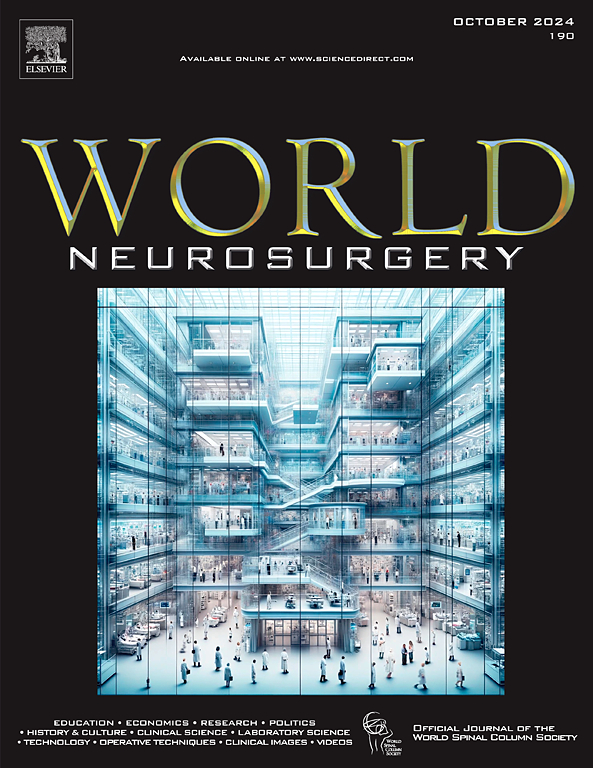Risk Factors for Hemodynamic Depression After Carotid Stenting
IF 1.9
4区 医学
Q3 CLINICAL NEUROLOGY
引用次数: 0
Abstract
Background
The effects of different stents and morphology of the stenosis on hemodynamic depression (HD) and in-stent restenosis (ISR) are unclear after carotid artery stenting.
Methods
142 patients were retrospectively enrolled and stratified into straight stent and tapered stent (TS), and further stratified according to stenosis morphology to compare the differences in final events. Logistic analysis was used to determine the risk factors for the occurrence of HD.
Results
TS had a lower incidence of postprocedural HD (38.8% vs. 60.0%; P = 0.012) and 1-year ISR (1.5% vs. 8.0%; P = 0.078). In centripetal stenosis, there was no significant difference in postprocedural HD between the different stents (27.3% vs. 47.8%; P = 0.155). In contrast, for eccentric stenosis, TS was associated with a reduced risk of postprocedural HD (42.2% vs. 67.3%; P = 0.013). Logistic analyses found that eccentric stenosis (odds ratio [OR] = 2.561; 95% confidence interval [CI] = 1.100–5.965; P = 0.029), high-echo plaque (OR = 5.877; 95% CI = 1.472–23.462; P = 0.012), open-cell stent (OR = 3.173; 95% CI = 1.067–9.436; P = 0.038), and distal diameter of stent (OR = 1.541; 95% CI = 1.104–2.153; P = 0.011) were risk factors for postprocedural HD. The following factors were identified as risk factors for persistent hemodynamic depression: high-echo plaque (OR = 7.605; 95% CI = 2.105–27.468; P = 0.002) and open-cell stent (OR = 7.017; 95% CI = 1.384–35.583; P = 0.019); additionally, the further the minimum lumen distance from the carotid bifurcation, the lower the risk of persistent hemodynamic depression (OR = 0.942; 95% CI = 0.894–0.992; P = 0.024).
Conclusions
TS reduces the risk of postoperative HD and there is a trend toward a lower risk of ISR at 1 year after the procedure. Eccentric stenosis, high-echo plaque, open-cell stent, and distal diameter of stent are high-risk factors for HD.
颈动脉支架术后血流动力学抑制的风险因素。
本文章由计算机程序翻译,如有差异,请以英文原文为准。
求助全文
约1分钟内获得全文
求助全文
来源期刊

World neurosurgery
CLINICAL NEUROLOGY-SURGERY
CiteScore
3.90
自引率
15.00%
发文量
1765
审稿时长
47 days
期刊介绍:
World Neurosurgery has an open access mirror journal World Neurosurgery: X, sharing the same aims and scope, editorial team, submission system and rigorous peer review.
The journal''s mission is to:
-To provide a first-class international forum and a 2-way conduit for dialogue that is relevant to neurosurgeons and providers who care for neurosurgery patients. The categories of the exchanged information include clinical and basic science, as well as global information that provide social, political, educational, economic, cultural or societal insights and knowledge that are of significance and relevance to worldwide neurosurgery patient care.
-To act as a primary intellectual catalyst for the stimulation of creativity, the creation of new knowledge, and the enhancement of quality neurosurgical care worldwide.
-To provide a forum for communication that enriches the lives of all neurosurgeons and their colleagues; and, in so doing, enriches the lives of their patients.
Topics to be addressed in World Neurosurgery include: EDUCATION, ECONOMICS, RESEARCH, POLITICS, HISTORY, CULTURE, CLINICAL SCIENCE, LABORATORY SCIENCE, TECHNOLOGY, OPERATIVE TECHNIQUES, CLINICAL IMAGES, VIDEOS
 求助内容:
求助内容: 应助结果提醒方式:
应助结果提醒方式:


